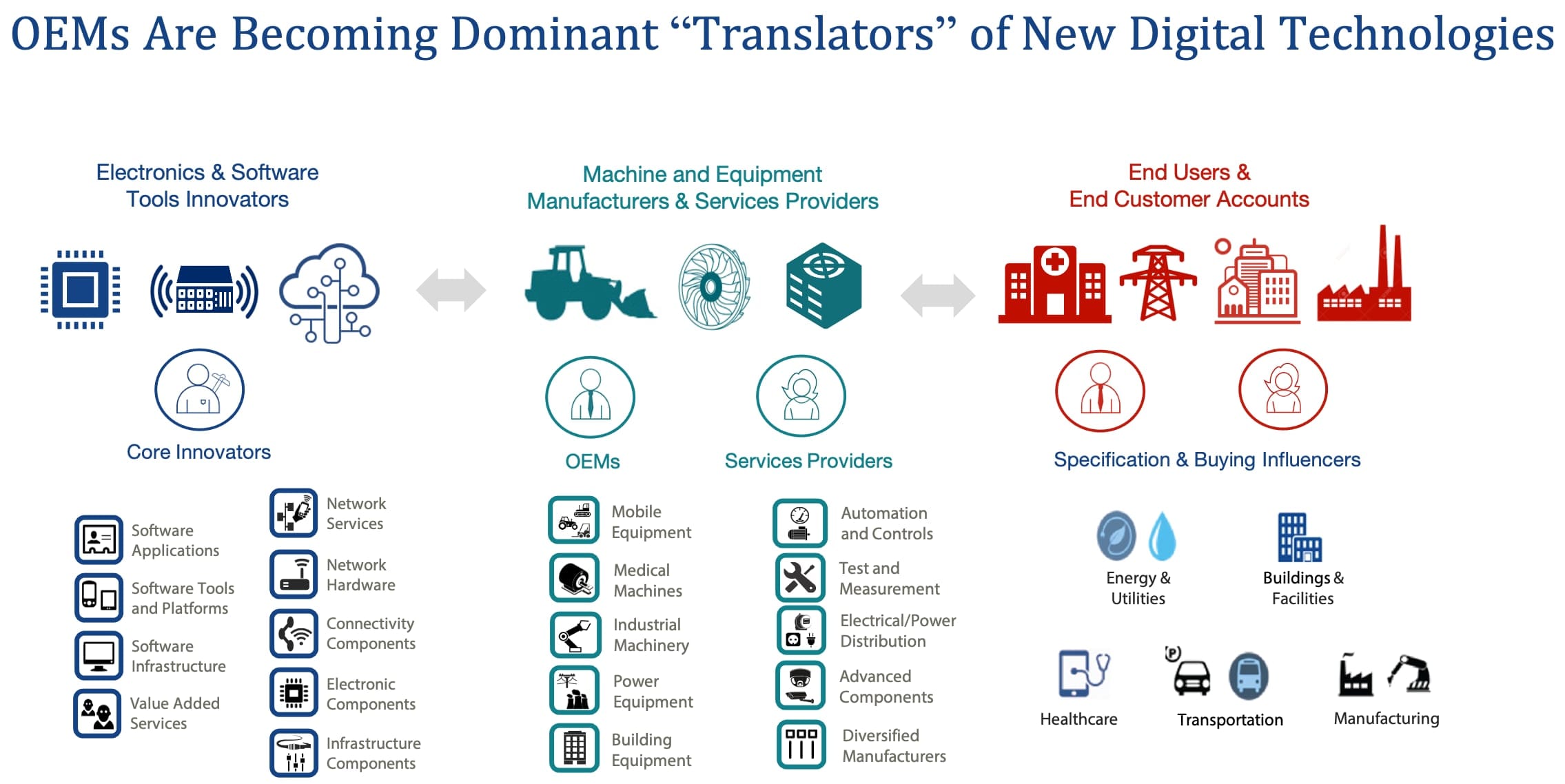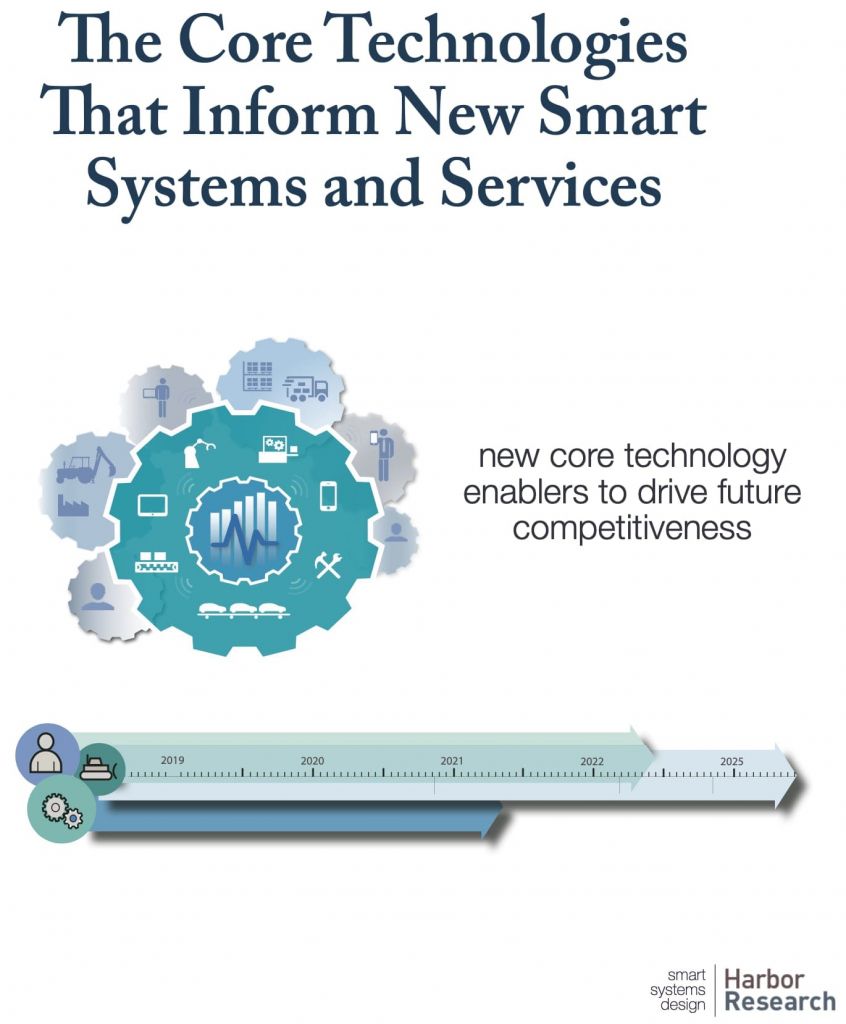To stay competitive, OEMs will need to sustain momentum in their core business while developing new digital and Smart Systems capabilities and solutions. The assumption that the primary role of an equipment manufacturer is only about sustaining their core product business no longer works. OEMs need to think about new growth businesses in a manner that transcends their core products or services.
THE PARADOX OF TECH DEVELOPERS AND OEMS
In today’s digitally driven world, hardware and software technology developers have largely focused their core development work and innovations on “horizontal” opportunities. This has left the task of translating core, horizontal technologies into vertical solutions to equipment OEMs along with services providers and other value-adding intermediaries like systems integrators.
In many market sectors, the manufacturers of equipment, machines and myriad devices that are used in everything from heavy industry, to commercial services, to individual homes have been a driving force in the development of vertically focused solutions.
Core technology developers and OEMs exist in a paradoxical relationship. The relentless march of silicon, hardware, and software innovations creates pressure on leadership in OEMs and their organizations to adopt new and novel technologies and adapt their strategies. Yet, as we have so often observed, established businesses, and especially machine and equipment OEMs, have difficulty changing because they are designed not to change.
At the end of the day, any successful business is really a bureaucracy that is organized to perform processes and tasks with uniformity and regularity. This inherent attribute presents the strategic innovator with a dilemma; OEMs must innovate to survive, but they must also resist innovation to survive.

This problem is exacerbated by two critical factors—determining the correct timing to adopt new technology, which is often ambiguous in the moment and only clear in hindsight, and anticipating what organizational adaptations or new business and operating models might be required to successfully apply a new technology. We continue to observe how difficult it has been for many OEMs to integrate new digital, smart systems and IoT technology into their core business.
While we strongly believe Smart Systems, software, and IoT technologies will play a central role in OEMs’ strategies going forward, it is also true that the trade-off decisions that many managers will face are going to be exacerbated by the pace of Smart Systems and IoT technology innovation. Should they invest more in their core business or invest more in new innovations?
Trying to reconcile the respective roles of new systems and customer innovation with sustaining the core business often creates negative contention. We see the continuously evolving relationship between these two dimensions of a business as fertile ground for innovation—if they are interwoven and mutually supportive.
NEW THINKING ABOUT NEW SOLUTIONS
What’s required is a true shift in thinking about how new systems and solutions will be developed. OEM business and technical strategists need to creatively imagine fully developed application solutions, ecosystems, and whole marketplaces. Being able to achieve this requires enough knowledge about core technologies to firmly grasp their impacts. The major core enabling technologies that most, if not all, OEMs will need to better understand include:
- Higher performance, higher quality, and more reliable mission critical wireless networks that enable new smarter sensors and sensor data fusion tools;
- More “democratized” distributed data and information architecture standards to inform data sharing and data fusion for analytics and machine learning;
- Easier and less costly data management, modeling and analytics application development tools; and finally,
- A new generation of software development and integration platforms that enable free flowing data discovery, data aggregation, integration and fusion, as well as collaborative application development.
To stay competitive, OEMs will need to sustain momentum in their core business while developing new digital and Smart Systems capabilities and solutions. The assumption that the primary role of an equipment manufacturer is only about sustaining their core product business no longer works. OEMs need to think about new growth businesses in a manner that transcends their core products or services.
When traditional business practices and company culture inhibit an organization’s ability to adopt new innovations, or when traditional operating models constrain the ability to develop new technical skills and capabilities, that is when an OEM needs to seriously consider alternative innovation modes and non-traditional organizational maneuvers.
Please read our download on the core technologies that drive Smart Systems innovation. We welcome your comments and feedback.
This essay is supported by Harbor’s Technology Insight
“The Core Technologies That Inform New Smart Systems and Services.”
Fill out the form below to download it for free.






